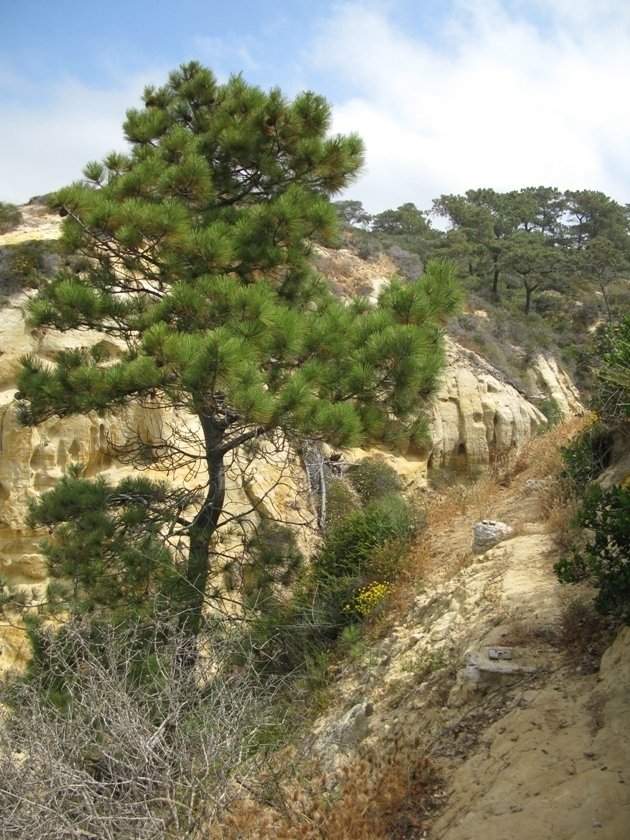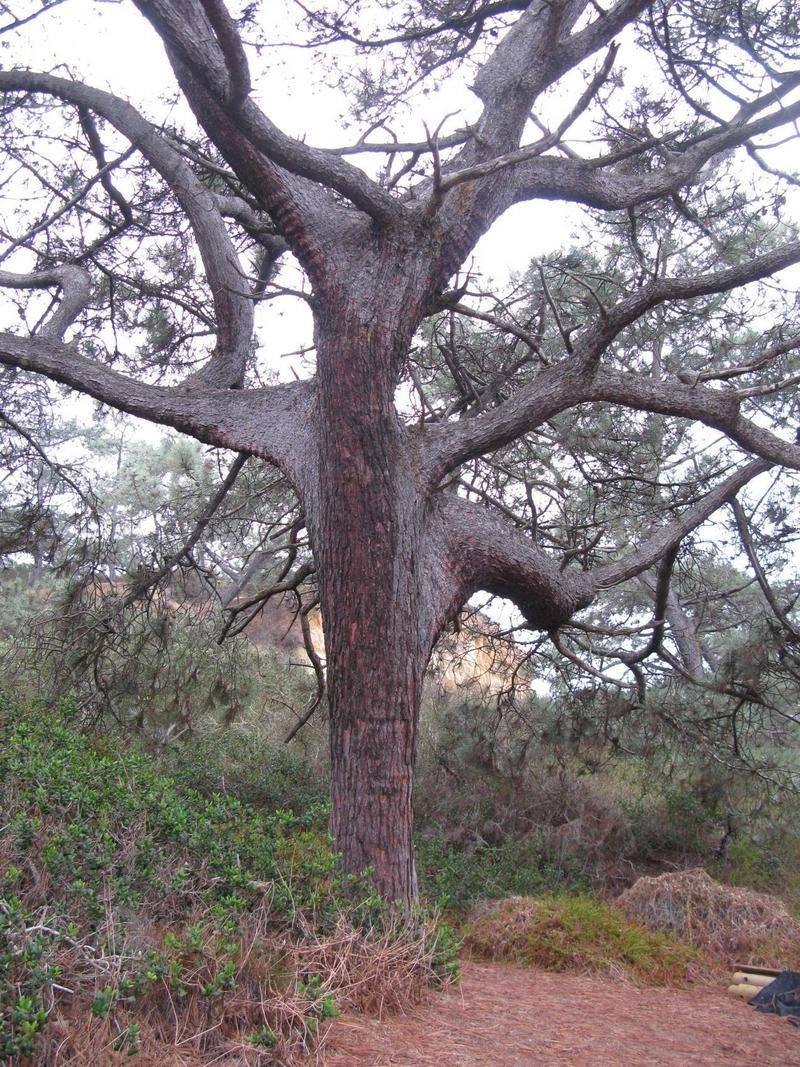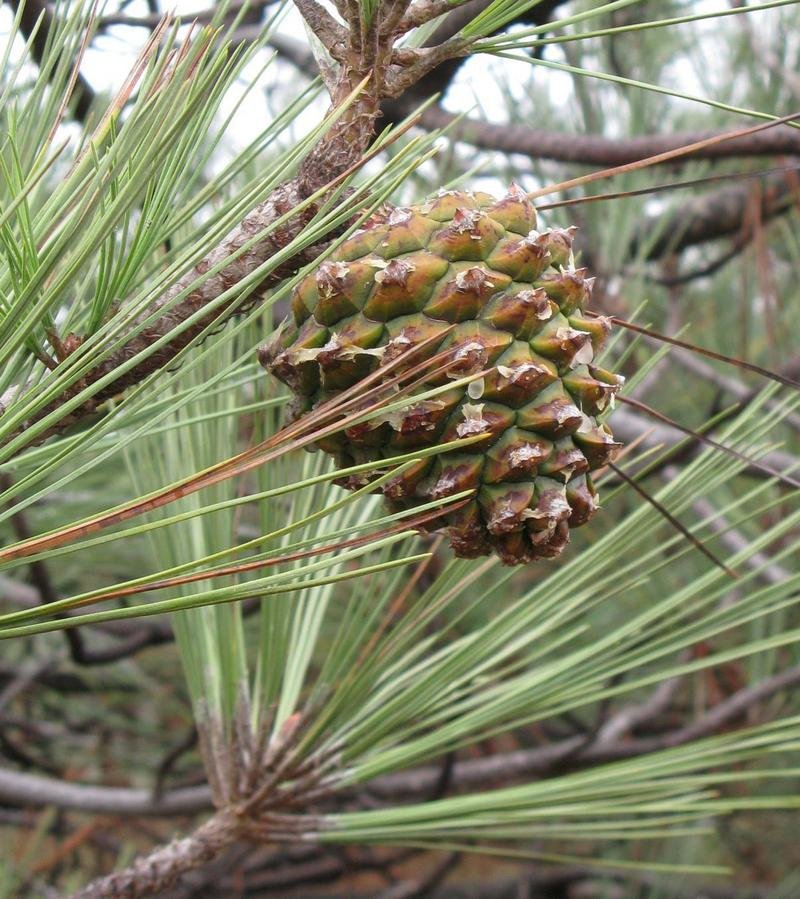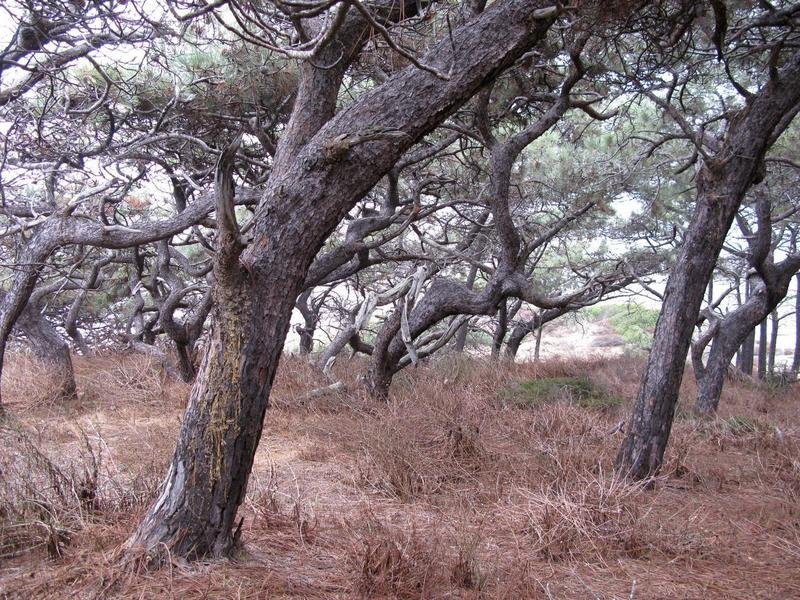





The Torrey pine is the rarest pine in the United States and one of the rarest pines in the world. There are estimated to be around 9,000 trees in the wild. That may sound like a fairly large number, but if the trees were planted tree farm style at 25 feet apart, all 9,000 would fit on a farm of around 130 acres.
Torrey pines (Pinus torreyana) are native to coastal hills and bluffs in the Del Mar area of southern California and to Santa Rosa Island, which is off of the coast of Santa Barbara County, California. They are found in small groves in the coastal chaparral plant community. The prehistory of the Torrey pine is a mystery. The two current wild populations are located 175 miles apart and it has been theorized that during cooler or wetter times, the West Coast as far north as Oregon was populated with groves of Torrey pines, but fossils have never been found to prove this.

Mainland Torrey pines in natural habitat
The island and mainland populations are considered separate subspecies, with Pinus torreyana subsp. insularis being the Santa Rosa Island population and Pinus torreyana ssp. torreyana being the mainland population. Island trees are usually shorter and more sprawling and to have broader cones and shorter needles than mainland trees. Island trees have many times more of the compound beta-phellandrene in their oleoresin than mainland trees. The island population is found only in one grove and if considered a separate entity, may be the rarest pine in the world.
Average rainfall in the natural range of the trees is from 10 to 12 inches, but fog adds much more precipitation and allows the trees to survive the rainless summer. Grooves on the needles channel dew and fog droplets to the ground and the waiting roots. Torrey pine needles are among some of the world's longest. They may be up to 13 inches long, but average around 9 inches. The roots of the tree can extend for 200 feet.
Fire is a mixed blessing for the Torrey pine. Fire kills the trees but the germination of seeds is much greater after a fire. Obviously, if fires keep occur at so great a frequency that the trees cannot get old enough to produce seeds, the species would be wiped out in that area. Since fire is a very real part of southern California ecosystems, that may explain, at least in part, why the natural range of the tree is so small.
Torrey pine cones take three years to mature and the cones can remain on the tree for five years or so. The seeds are gradually released out of the cone over a period of several years. This is perhaps an adaptation to fire. Seeds can remain viable for at least ten years. The seeds are large and cannot be carried by the wind. They must be dispersed by birds or other animals.
Torrey pines are grown ornamentally well outside of their historic range. They are not uncommon landscaping plants in coastal southern California and have been grown in places as widespread as Australia, New Zealand, and Kenya. PlantFiles recommends the tree for USDA zone 8 and higher. The recommended Sunset zones are 8, 9, and 14-24 which correspond to low elevation, non-desert California. The trees should be planted in full sun and are accepting of poor soil. Trimming and pruning should be done with care. Large branches will die back to the trunk if cut.
In windy areas, the trees remains shortened and sculpted by the wind but in sheltered locations, can reach about 75 feet in height. Cultivated plants can get over 100 feet tall. The tallest known Torrey pine is found outside of the historic range and is in Carpinteria, California. It is a historic landmark planted in 1894 and was measured at 126 feet in 1993.



In the past, human activities were a threat to the Torrey pine, but now most of the wild trees and their habitat are protected in the Torrey Pines State Reserve and Channel Islands National Park. In recent years, the biggest threat to the mainland trees has been bark beetles. By 1990, twelve percent of the adult trees, which were also drought-stressed at that time, had been killed by bark beetles. In 1991, pheromone traps were set up to catch the beetles and since that time only one additional tree has been attacked.
Torrey pines are rare in nature but they can be grown outside of their tiny native range. Cultivated specimens can be seen in virtually any southern California botanic garden and the aforementioned Carpinteria tree is accessible to the public. The trees in their native range are treasured and are being successfully protected. These trees can be visited, with the Torrey Pines State Reserve being the much more accessible location.
All photos were take at Torrey Pines State Reserve.

References
Brenzel, Kathleen Norris, Western Garden Book, Sunset Publishing Company, 2001
Hubbs, Carl L., Whitaker, Thomas W., and Reid, Freda M.H., Torrey Pines State Reserve, The Torrey Pines Association, 1991
Lanner, Ronald M., Conifers of California, Cachuma Press, 1999
U.S. Forest Service, http://www.fs.fed.us/database/feis/plants/tree/pintor/all.html
Copyright © www.100flowers.win Botanic Garden All Rights Reserved